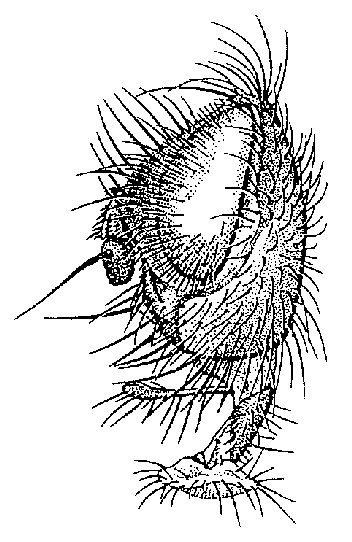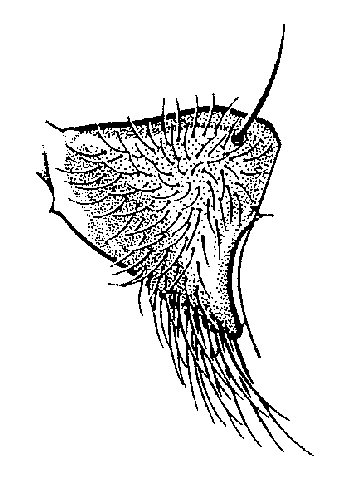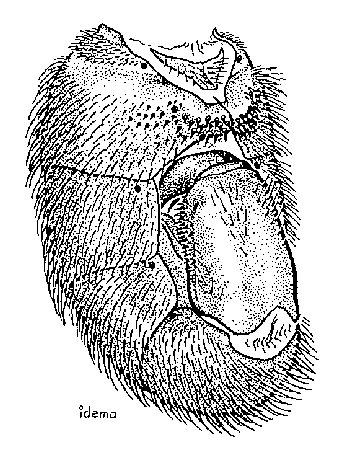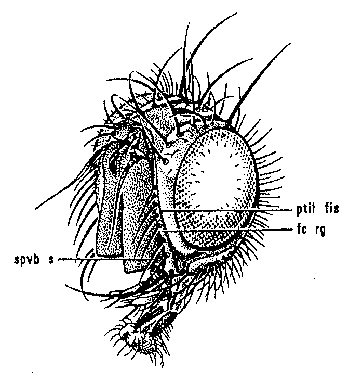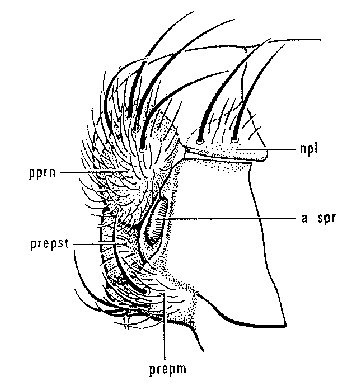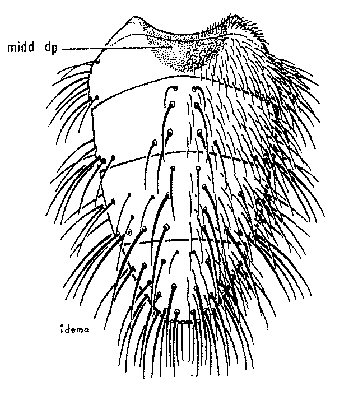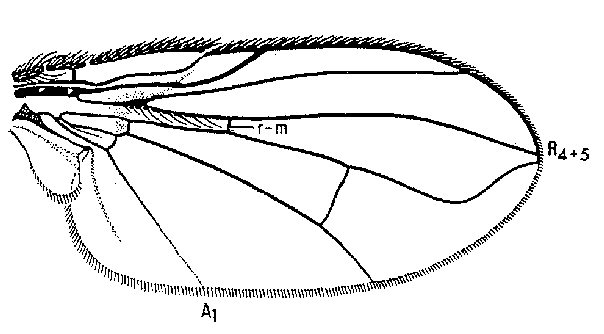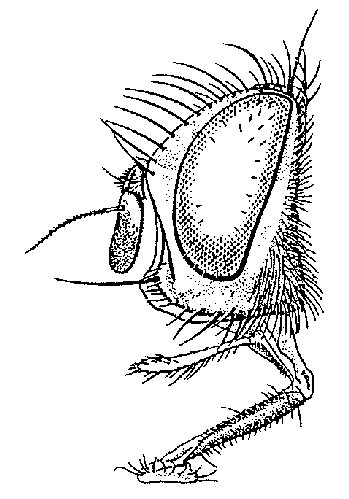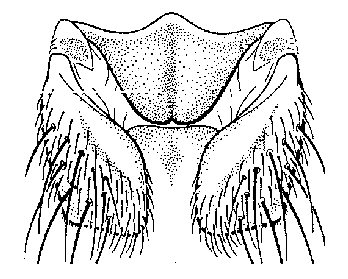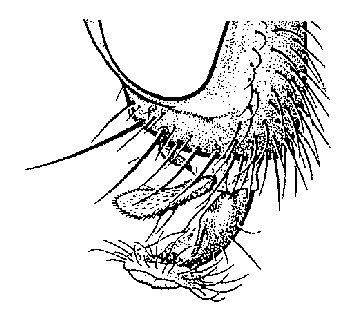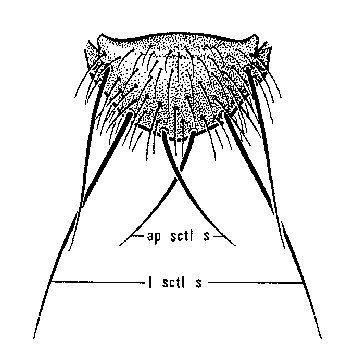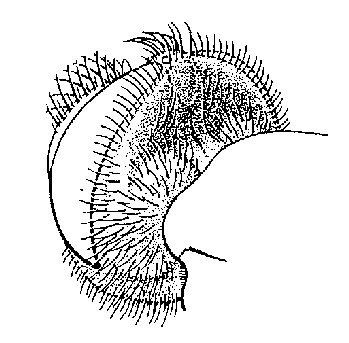|
Key to the genera of Tachinidae in the eastern US Fourth page of the Tachinid key. See page one for information and initial key points. Eastern species list. |
|
197. Eye with short sparse hairs; each hair no longer than combined diameter of two or three facets
Goniocera B. & B. (1/1) io Aldrich
197. Eye densely covered with conspicuous long hairs
197A
197A. Pedicel with dense patch of stout erect bristles, each about as long as width of pedicel at point of attachment. Longest parafacial hairs more than half as long as arista
M. tibialis
Metopomuscopteryx Townsend (1/3) tibialis Coquillett
197A. Pedicel with few, sparse hairs and one or tow bristles, most shorter than width of pedicel. Parafacial hairs at most less than one-third as long as arista
M. obscura
Macquartia R-D. (2/7)
198. Scutum without bristles except for one pair of each of the following: presutural supra-alar, posteriormost presutural, postsutural supra-alar, postsutural intra-alar, postsutural dorsocentral, and postsutural acrostichal; usually only one katepisternal bristle present, in posterodorsal corner (below). Abdominal tergites without dorsal bristles
199
198. Scutum with two or more pair of postsutural supra-alar, dorsocentral, and acrostichal bristles; katepisternum with two or more bristles (below). Abdominal tergites usually with at least one pair of marginal bristles
199. Hind tibia with dorsal longitudinal row of long flattened blade-like setae, each as long as width of tibia at its point of attachment, flanked by a second row of similarly shaped but much shorter setae
Trichopoda Berthold (5/6 in 2 subgenera)
199. Hind tibia lacking rows of long flattened setae
200
200. Palpus minute, much shorter than pedicel. Abdomen orange-red without dark markings, convex dorsally, twice as long as wide, and covered with prominent recumbent black hairs, none of which is enlarged or bristle-like; apex of abdomen of female folded ventrally; ventral edges of tergite 2 studded with spine-like setae
B. brevipennis
Besseria R-D., in part (2/3)
200. Palpus well-developed, longer than pedicel and usually longer than antenna. Abdomen, if orange-red, with dark markings; apex of abdomen of female not folded ventrally and not opposed by spine-like setae on ventral side of tergite 2
201
201. Abdomen flattened dorsally, distinctly longer than wide, usually dark colored, but if pale in ground color, then densely pruinose
Phasia Latreille (10/16)
201. Abdomen hemispherical dorsally, scarcely longer than wide, orange red in ground color, usually with dorsal dark markings, sometimes almost black in female
202
202. Apex of scutellum without bristles; apical pair so widely separated and short that they appear as lateral bristles and cannot cross at their apices. Abdomen shiny, orange red with black markings, or sometimes entirely black, with short hairs each arising from a raised base, giving abdomen a somewhat rugose appearance. Pedicel and first flagellomere in most species elongate, extending to level of vibrissa
G. canadensis
Gymnosoma Meigen (5/6)
202. Apex of scutellum with the usual crossed pair of apical bristles. Abdomen usually golden tomentose (in male) or gray tomentose (in female); intertergal sutures distinct. Pedicel and first flagellomere short, not extending to level of vibrissa
G. immaculata
Gymnoclytia B. & B. (5/6)
203. Postmetacoxal area sclerotized, i.e. posterior edges of metepimera extending posteromedially to meet each other at midline between hind coxae and base of first abdominal sternite, forming a postmetacoxal bridge
204
203. Postmetacoxal area membranous, distinctly paler in color than adjacent metepimera
206
204. Hind margin of eye indented. Ocellar triangle extending forward to lunule as a polished brown strap-like sclerite
Hemyda R-D. (1/1) aurata R-D.
204. Hind margin of eye straight or evenly convex. Ocellar triangle normal in shape, not dividing frontal vitta
205
205. Palpus present. Vibrissae arising distinctly above lower margin of face. Legs yellowish basally, darkened apically
Xanthomelanodes 2nd Townsend (3/5)
205. Palpus absent. Vibrissae level with lower margin of face. Legs entirely dark
Cylindromyia Meigen (11/17 in 5 subgenera)
206. M ending in R4+5 well before wing margin
207
206. M ending in wing margin or in R4+5 near margin
207. Ocellar bristles lateroclinate or slightly reclinate. Calypter usually white, exceptionally large, extending beyond middle of syntergite1+2. Apex of female abdomen with pincers-like cerci, each with sharp apex and peg-like setae on inner margin
Leucostoma Meigen (5/9)
207. Ocellar bristles proclinate or absent. Calypter not extending back to middle of syntergite1+2. Apex of female without pincers-like cerci (except in Clairvillia)
208
208. Wing slender, usually darkened with whitish apex. M beyond bend meeting R4+5 at right angles; R4+5 + M twice as long as portion of M beyond bend
Catharosia Rondani (3/5)
208. Wing not as described above; M not so abruptly bent anteriorly
209
209. Wing patterned with brown spots, bars, and triangles
210
209. Wing transparent, unpatterned
211
210. Face with prominent oval central tubercle or carina. Antenna long, cylindrical; pedicel and first flagellomere each as long as arista. Lunule without setae. Thorax black. Apex of cell R4+5 dark
210. Face with at most a low indistinct keel-like carina between antennae. Antennae short; length of pedicel and first flagellomere together no longer than arista. Lunule, in some species. With setulae. Thorax yellow or pale brown. Apex of cell R4+5 transparent
O. clausa
Oestrophasia B. & B. (3/4 in 2 subgenera)
211. Proboscis extremely long and slender, curving forward, longer than height of head. Face pruinose, with thickened flat-topped carina separating very short antennae. Tergite 7 of female divided medially into two spine-covered lobes
Imitomyia Townsend (1/1) sugens Loew
211. Proboscis not exceptionally long, shorter than height of head. Face without a prominent carina. Tergite 7 of female without spine-covered lobes
212
212. Eye very large, occupying almost all of side of head; gena reduced to a narrow band less than one-tenth height of head
S. triangulifera
Strongygaster Macquart, in part (3/4)
212. Gena much wider, one-sixth height of head and more
213
213. Eye covered with conspicuous dense hair. Facial ridge with setae on lower two-thirds or more; the uppermost of these setae situated at level of lowest frontal bristles; frontal bristles extending ventrally below level of base of arista
M. fracida
Mactomyia Reinhard (1/1) fracida Reinhard
213. Eye bare. Setae of facial ridge, if present, below level of lowest frontal bristle; frontal bristles not descending below level of base of arista
V. atrophopodoides
Vanderwulpia Townsend (1/2) sequens Townsend
214. Eye almost entirely covered with long hairs
215
214. Eye apparently bare
215. Ocellar bristles posterolaterally inclined; facial ridge with row of stout erect evenly spaced bristles. Proepisternum with pale hairs
C. semiotisthae
Campylochaeta R-D. (9/11)
215. Ocellar bristles proclinate or absent; facial ridge bare or with recumbent setae on lower half. Proepisternum bare
216
216. Palpus reduced, parallel-sided, usually shorter than pedicel
L. tessellata
Linnaemya R-D., in part (4/7 in 2 subgenera)
216. Palpus clavate, normal in length, longer than pedicel
217
217. Body and most of head metallic green or blue
Gymnocheta R-D. (2/4)
217. Body and head yellowish brown or black, not metallic green
218
218. Middle basal bristle of postpronotum displaced anterolaterally, arising between anterior bristle and outer basal bristle or lateral to a line between them, and forming a nearly right-angled triangle with outer and inner basal bristles
219
218. Middle basal bristle of postpronotum in line with outer and inner basal bristles
219. Face convex, visible in profile; lower margin protruding anterior to vibrissal angle
P. ampelus
Panzeria R-D. (16/29)
219. Face flat or deeply concave; neither central part nor lower margin visible in profile 220
220. Abdominal tergite 5 orange, contrasting with dark preceding tergites; tergites 3 and 4 each with two pair of discal bristles, with one pair anterior to the other
Hineomyia Townsend (1/1) setigera Coquillett
220. Abdominal tergites concolorous; tergites 3 and 4 each with one pair of discal bristles or none
221
221. Large species, over 8mm, shiny black or dark reddish brown, with yellow upper and lower calypteres and wing base. Antenna black
Melanophrys Williston (1/2) insolita Walker
221. Small species, less than 6mm, grayish brown to blackish, pruinose, with white calypteres and wing base. Antenna orange
Hyalurgus B. & B. (2/2)
222. Anepimeral bristle well-developed, extending back well beyond middle of lower calypter
223
222. Anepimeral bristle shorter, not extending to middle of lower calypter
223. Arista thickened nearly to apex
224
223. Arista thickened on less than basal half, tapering before middle to long thread-like apex
Return to 76
224. Frontal bristles extending ventrally, in an evenly spaced row, nearly to lower margin of parafacial. First flagellomere of male sometimes divided longitudinally into two or three branches
D. robusta
Dichocera Williston (2/6)
224. Frontal bristles extending ventrally only to level of base of first flagellomere; parafacial with a few hairs below lowest frontal bristle. Antenna of male undivided
O. aristalis
Ostracophyto Townsend (1/2) flavicaudalis O'Hara
225. Middorsal depression on abdominal syntergite 1+2 extending back to hind margin of syntergite
226
225. Middorsal depression scarcely extending back beyond middle of syntergite
227
226. Anterior and posterior lappets of posterior thoracic spiracle nearly equal in size; each lappet composed of a row of plumose hair-like extensions. Lower margin of face not protruding beyond vibrissal angle
Uramya R-D. (3/7)
226. Anterior and posterior lappets unequal in size; posterior lappet subcircular. Lower margin of face protruding well beyond vibrissal angle. Arista slender. Palpus clubbed apically
Eriothrix Meigen (1/1) penitalis Coquillett
227. Base of R4+5 without setae, dorsally or ventrally. Scutellum with lateral, subapical, and apical bristles all more or less equivalent in size; apical bristles parallel or divergent. Antennal axis of head 1.5 times that of vibrissal axis
C. bigelowi
Cleonice R-D. (2/3)
227. Base of R4+5 with setae both dorsally or ventrally. Scutellum with stout divergent lateral bristles, short weak subapical bristles, and stout crossed apical bristles. Antennal axis of head less than 1.5 times that of vibrissal axis
228
228. Genal groove relatively large, triangular, formed by sparation of parafacial and genal dilation from vibrissal angle. Eye height about two-thirds height of head. Three postsutural intra-alar bristles present
M. obscura
Macquartia R-D., in part (2/7)
228. Genal groove nearly obliterated by the meeting of genal dilation, parafacial, and vibrissal angle. Eye height about four-fifths height of head. Two postsutural intra-alar bristles present
D. americana
Dufouria R-D. (1/1) americana Reinhard
229. Palpus minute, shorter than pedicel or absent
230
229. Palpus well-developed, longer than pedicel
230. Hind margin of eye indented. Prementum slender, elongate, more than twice as long as height of head. Abdomen orange red, slender, contrasting with dark wings
B. aelops
Beskia B. & B. (1/1) aelops Walker
230. Hind margin of eye straight or evenly convex. Prementum shorter than height of head. Abdomen and wings not as above
231
231. Large species, 10 mm or more in length. Head and body mostly yellowish or pale brownish pruinescent. Abdomen slender, pointed apically. Apical scutellar bristles about half as long as subapical scutellar bristles; lateral scutellar bristles undeveloped
Icelia R-D. (1/1) triquetra Olivier
231. Smaller species, under 7 mm in length. Head and body mostly black or gray. Abdomen black. Apical scutellar bristles as long as lateral scutellar bristles; subapical scutellar bristles reduced
232
232. Abdominal sternites unsclerotized; edges of tergites widely separated midventrally, connected by pale membrane, with terminalia tucked into resulting cavity; intersegmental junction between tergites 4 and 5 more prominent than between tergites 2 and 3 or tergites 3 and 4. Cell R4+5 opening at apex of wing
Besseria R-D., in part (2/3)
232. Abdominal sternites fully sclerotized; connecting edges of tergites with little or no membrane exposed; intersegmental junctions between tergites 2-5 all equally will-defined. Cell R4+5 ending before apex of wing
Eloceria R-D. (1/2) nigra Coquillett
233. Ocellar setae inclined laterally or posterolaterally
Clairvillia R-D. (1/3) timberlakei Walton
233. Ocellar setae proclinate or absent
234
234. Medial surface of fore coxa entirely covered with appressed setulae
Thelaira R-D. (1/2) americana Brooks
234. Medial surface of fore coxa bare; appressed setulae confined to anteromedial surface with bare area medially
235
235. Lower proepimeral bristle well-developed, directed anteroventrally, in opposite direction to upper proepimeral bristle
Neaera R-D. (3/3)
235. Lower proepimeral bristle absent, or reduced in size and directed dorsally, parallel to upper proepimeral
236
236. M not reaching wing margin, ending about where bend should be
Besseria R-D., in part (2/3)
236. M reaching wing margin, with bend in usual position
237
237. Vibrissa not distinctly differentiated; genal groove exceptionally large; postgenal margin rather straight and vertical, ending below eye
E. exilis
Eutrixa Coquillett (1/2) exilis Coquillett
237. Vibrissa distinctly differentiated; postgenal margin extending forward below eye forming a distinct genal dilation
238
238. Prosternum inflated
Ormia R-D. (8/9)
238. Prosternum normal
239
239. Face convex, visible in lateral view, at least on lower half
240
239. Face concave at least on upper half, not visible in profile except sometimes at vibrissal angle
240. Mid tibia with only one anterodorsal bristle or none
241
240. Mid tibia with two or more anterodorsal bristles
244
241. Pleuron with dense tufts of long white plumose hairs
Leskiopsis Townsend (1/1) thecata Coquillett
241. Pleuron hairs not plumose and not especially long or dense
242
242. R4+5 setose more than halfway to crossveing r-m. Postpronotum with a small anterolateral bristle in addition to the basal bristles
Genea Rondani (7/7 in 2 subgenera)
242. R4+5 with a few setae at base only. Postpronotum lacking an anterolateral bristle
243
243. Mid tibia with one anterodorsal bristle
Leskia R-D. (2/3)
243. Mid tibia without an anterodorsal bristle
Drepanoglossa Townsend (1/2) tenuirostris Reinhard
244. Arista thickened on basal two-thirds or more, tapering abruptly to slender apex. Prementum longer than fore femur
Aphria R-D. (2/2)
244. Arista thickened on less than basal half, tapering gradually and uniformly to apex. Prementum shorter than fore femur
Solieria R-D. (1/5) flava Townsend
245. Prementum long and slender, often curved posteriorly, at least as long as height of eye, and in most species longer than height of head; labella minute, pointed, scarcely wider than apex of prementum
246
245. Prementum shorter than height of eye; labella normal, pad-like
248
246. Posterior margin of eye slightly concave (see image above). Antenna arising near level of middle of eye; first flagellomere no longer than half height of eye. Scutellum with well-developed lateral bristles
Epigrimyia Townsend (2/2)
246. Posterior margin of eye convex. Antenna arising near upper margin of eye; first flagellomere large in both sexes, as long as height of eye. Scutellum lacking lateral bristles
247
247. Membrane between lower facial margin and clypeus with a pair of convex subtriangular sclerites. Aristomere 2 elongate, two or more times as long as wide; first flagellomere truncate, widest beyond middle
C. politura
Clausicella Rondani (6/8)
247. Membrane between lower facial margin and clypeus without above mentioned sclerites. Aristomere 2 minute, no longer than wide; first flagellomere rounded apically, widest before middle
Crocinosoma Reinhard (1/1) cornuale Reinhard
248. Arista plumose, with the longest hairs longer than greatest width of arista
249
248. Arista bare, or nearly so, with the longest hairs shorter than greatest width of arista
249. Aristal hairs much longer at base of arista than at apex, arising all around arista. Parafacial with minute pale hairs. Midleg of male about twice as long as foreleg or hindleg
Cholomyia Bigot (1/1) inaequipes Bigot
249. Aristal hairs as long at apex of arista as on base (see images at 248). Parafacial bare. Midleg of male not exceptionally long
250
250. Genal dilation extending anteriorly to vibrissal angle and parafacial, reducing genal groove to a sulcus. Small shiny brown species with little pale pruinosity
Anthomyiopsis Townsend (1/1) cypseloides Townsend
250. Genal dilation separated from vibrissal angle and parafacial by a distinct triangular pruinose genal groove. Species with extensive pale pruinose areas
251
251. Scutellum with well-developed lateral bristles in addition to basal and apical bristles (see below, except that lateral bristles are parallel or convergent). R4+5 setose at least to crossvein r-m. Facial ridge usually with a few pale hairs above vibrissa. Female with sword-like ovipositor protruding from apex of abdomen, except in elegans (Reinhard)
Spathidexia Townsend (6/7 in 2 subgenera)
251. Scutellum with well-developed basal and apical bristles only; lateral setae hair-like. R4+5 with one bristle at base. Facial ridge without pale hairs. Ovipositor tubular
Chaetonopsis Townsend (1/1) spinosa Coquillett
252. Scutum with only one pair of presutural acrostichal bristles, the posteriormost pair, which is situated anterior to scutellum
253
252. Scutum usually with two pairs of presutural and two pairs of postsutural acrostichal bristles
254
253. Scutellum without well-developed lateral bristles. Back of head convex
Euclytia Townsend (1/1) flava Townsend
253. Scutellum with well-developed lateral bristles as well as basal and apical bristles. Upper third or more of back of head concave
Opesia R-D. (1/1) americana Bigot
254. Eye, viewed in profile, occupying almost entire side of head, more than half as long (front to back) as high, thus reducing parafacial and gena to narrow bands
Strongygaster Macquart, in part (3/4)
254. Eye, viewed in profile, less than half as long (front to back) as high; parafacial, gena and postgena more extensive
255
255. Lateral scutellar bristles lacking
Phyllophilopsis Townsend, in part (2/2)
255. Lateral scutellar bristles well-developed
256
256. First flagellomere with sharply pointed apex. Scutellum short and broadly rounded, with crossed apical bristles and divergent lateral bristles arising rather far back between lateral and subapical position
Acemya R-D. (5/5)
256. First flagellomere rounded apically. Scutellum more triangular with truncate apex; subapical scutellar bristles long and divergent, arising from corners of truncate apex
257
257. Mid tibia without a ventral bristle. Abdomen of female arched ventrally, with telescopic ovipositor directed ventrally
Trigonospila Pokorny, in part (3/3)
257. Mid tibia with well-developed ventral bristle. Abdomen of female not modified and ovipositor directed posteriorly
258
258. Frons with row of proclinate orbital setae extending anteroventrally to level of lowest frontal bristle
Euhalidaya Walton, in part (1/1) genalis Coquillett
258. Frons with not more than two proclinate orbital bristles
259
259. Facial ridge thickened, protruding beyond parafacial, thus visible in profile, usually with small appressed setulae on lower half or more. Arista, when orange, thickened nearly to apex
Phasmophaga Townsend, in part (3/4)
259. Facial ridge narrow, without setae. Arista thickened only at base, tapering to long slender apex
260
260. Katepisternum with two bristles
Anisia Wulp, in part (4/4)
260. Katepisternum with three bristles
Opsomeigenia Townsend, in part (2/) (includes Euthelyconychia) (3/4)
|

